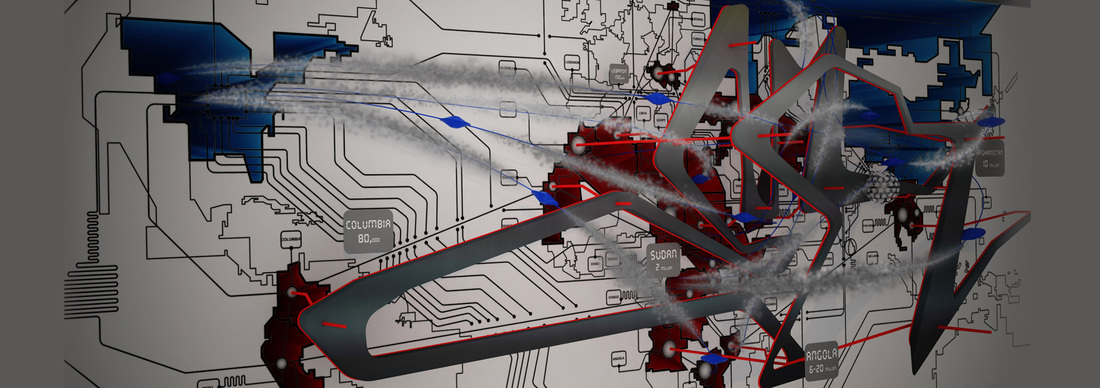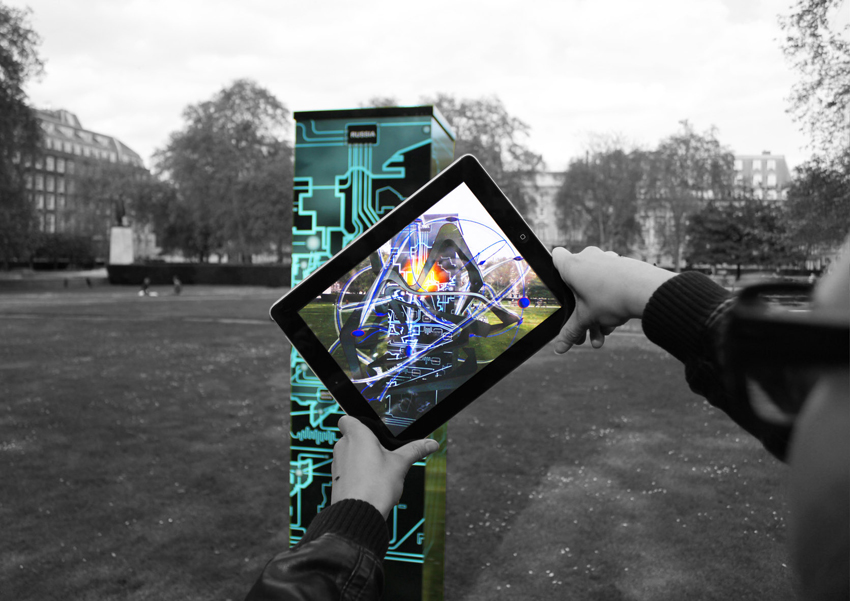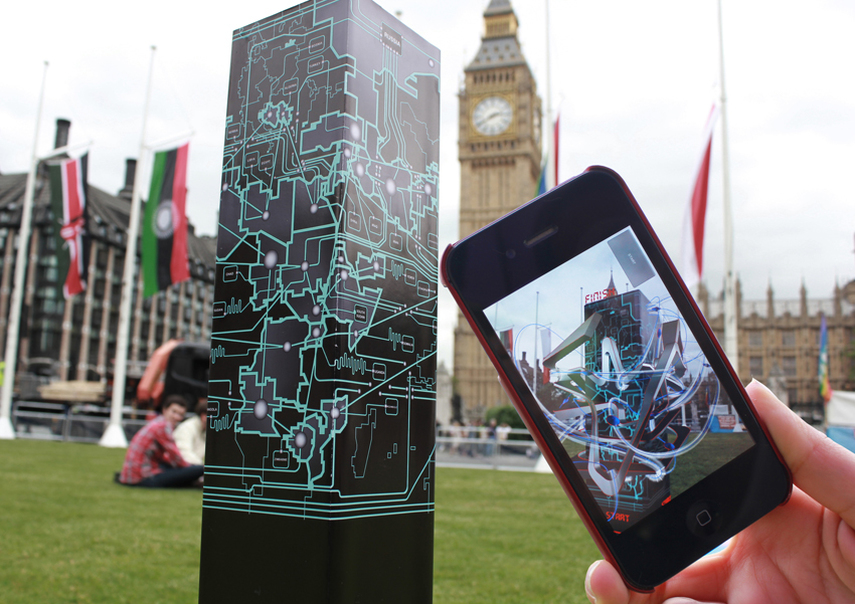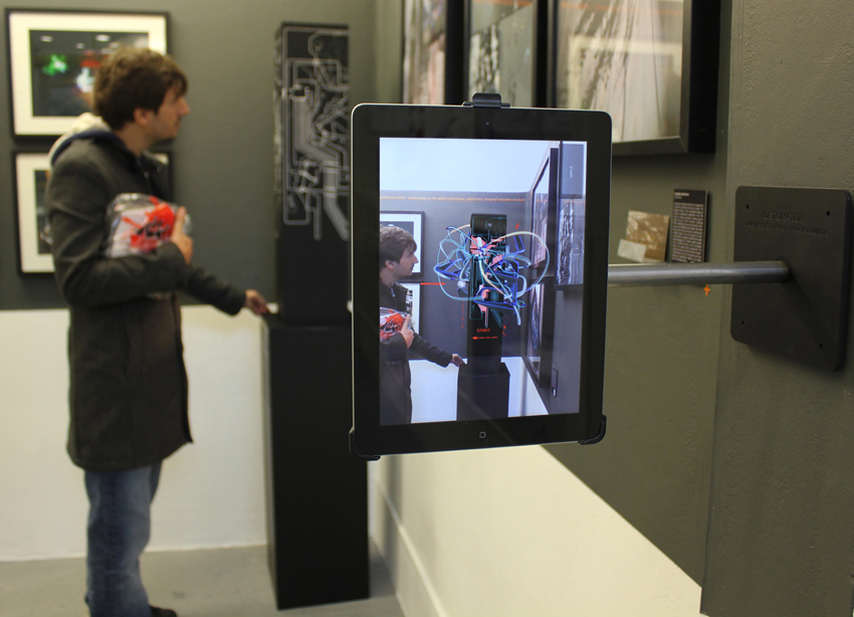|
An interactive game installation is proposed across a number of sites in London, by introducing a social game intervention known as “Detonator”. The game design is configured based on key data relating to the use of landmines during war in many regions of the world, as well as the continued refusal of countries that have not joined an international convention to ban the use of landmines. This data is mapped on a spatial route around a shame pole marking structure which provides participants with information and interaction with gaming elements through an augmented reality application. A Mine Kafon is utilised in this interactive playground to serve as a mine detonator which is guided by the participants throughout the AR landscape in the quest for full eradication. The main goal of this project is to create gaming hot spots which utilize augmented reality to transform the city into a series of interactive playgrounds. This ideally responds to the cultural/social and political conditions of the site to create an installation which will be a contextually relevant to the area and make visible the underlining political concerns of the site. The integration of technology which merges virtual data onto physical space has been deployed increasing in recent times. Furthermore the amalgamation of augmented reality technology into our visual perception beyond the limitations of mobile screens is already under construction through a multitude of wearable computing solutions in the form of glasses and lenses embedded with the necessary computing and tracking performance. The main focus of concern for this new paradigm of visual augmentation lies in the potential possibilities for incorporating new social experiences into the built environment which can transcend the physical limitations of built infrastructure and the hierarchies who govern our visual and social experiences. The use of augmented reality technology in the architectural practice has potential to go beyond visualisation of information and into the creation of new meaningful spaces of interaction and discourse. These new locations can exist parallel to the physical environment by reclaiming existing spaces to augment through new uses and programs. To enhance social activities and public expression in architectural spaces we can augment the environment with interactions which merge reality with digital practices that occur so often on social networking platforms. AR systems obey the open source principles, low capital costs and easily enhanced with human interaction and expertise. In this way the augmented reality architecture is a constantly developing system which can advance with mass involvement. An open architecture which is easily updated and regenerated based on growing and developing knowledge and expertise. Mixed reality lets us create architecture which isn’t invasive in the real world and doesn’t take up any physical space or material. AR provides a relevant method for choosing how to experience the built environment, as opposed to your experience being wholly guided by one hierarchical system. Furthermore AR has social consequences which can change the way we inhabit space to create time based architecture which allows for increased interaction in the public domain. Working with augmented reality provides a new outlet for reclaiming parts of an urban environment to provide a new use of space which is non-regulated, open source and social. In this way AR promotes free use of space, self-expression and occupancy in the quest for a responsive and adaptive public social space. AR environments need to address key characteristics which go beyond architectural criteria such as shelter, aesthetics and environmental conditions. This new hybrid space must offer uses that transcend the limitations of material architecture. The strength of this architecture allows for integration with the local or global network which provides uses beyond the local amenities of the site. From an architectural perspective, the potential of AR provides an infrastructure which can be accessed globally through the integration of participatory engagement with various online portals. This architecture becomes a hybrid system which is completely location specific, but is able to be accessed through an open network for increased participation and information. Hybrid space combines the use of the World Wide Web to give people the power to be open source, it gives us the control to take over space and introduce new communities into the built environment as part of a network distributed media which allows us to share information in a much more open manner. Hybrid space allows us to use social media and online communities to also change the use of space and provide new programmes into everyday environments as a form of time based architecture which connects and represents a community across the World Wide Web. People can share art and information in public spaces to reach a location specific audience which would often be impossible to reclaim in physical space alone. In augmented reality, space can be viewed as an open, free, communal domain which is altered and controlled by the public. The interactive qualities of the hybrid space allow people to contribute to the experience of their landscape which can provide an array of personalities, configurations to each location and presumably create a closer bond with their surroundings. The significance of hybrid space becomes elevated through an integration of responsive/ intelligent characteristics embedded within the environment which can understand the requirements of inhabitants individually. This architecture can cater for the changing needs of occupants through functionalities which can be switched on and off, as well as understanding your spatial locations, preferences and social networks. In this way, hybrid space represents a true vision of time based architecture which continually adjusts to user occupancy. The creation of hybrid space consists of mixed reality applications which are integrated into the everyday environments in the form of invisible, intangible interfaces which connect to buildings or spaces to create new locations of social engagement and interaction. This methodology defines architecture which is not simply designed through computation but more so one which becomes computation through a fusion of social, physical and electronic entities. The superimposition of virtual and physical space provides a method for exploring the way in which we connect to buildings based on the user’s requirements. This new environment becomes a form of hybrid architecture which requires ubiquitous computing to mediate the two dimensions. In hybrid space the architecture is no longer focused on fixed programmes, but more on how we utilise buildings and urban environment as shells or envelopes and superimpose new activities. Architectural spaces need to provide a multiplicity of uses; they have to be kept open, especially in dense urban context where the turnover, change, human progression/activities is fast. Furthermore in times of economic uncertainty, the possibilities to redevelop or construct a new structure to accommodate new uses become more difficult. The development of technology however, has a critical role in changing the way people communicate and view society, as well as how it can transform the way businesses deliver services and engage with the public. In augmented reality space, it becomes possible to advance the needs for social progression using new ways of inhabitation which is flexible to occupants. This flexibility is integral to the core essence of hybrid space, which allows people to inhabit buildings for a multitude of different tasks. The inclusion of augmented space within material architecture allows buildings to become hubs of cross disciplinary activity, possibly eliminating the need for single use buildings and satisfying the need for new infrastructure in a much more sustainable manner. Fundamentally the benefit of hybrid space addresses how architecture can respond to frequent change; this involves change regarding social, environmental, and political factors. Moreover the introduction of an augmented layer into the built environment considers how architecture’s significance changes in relation to its context. The hybridity of material and digital space allow for architecture to embrace cultural and social shifts and accommodate flexible and adaptive design strategies. For more information on Detonator please visit the project page:
0 Comments
Your comment will be posted after it is approved.
Leave a Reply. |
Darf BlogWelcome to Darf Blog. Categories
All
Archives
March 2024
|
Want more Information?
Our TeamAbout
|
HelpTutorials
|
LegalTerms of Use
|
All works © Darf Design 2020
Please do not reproduce without the expressed written consent of Darf Design
Please do not reproduce without the expressed written consent of Darf Design





 RSS Feed
RSS Feed
